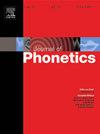Perceived cross-linguistic similarity of retroflexes in trilingual, bilingual and native listener groups
IF 2.4
1区 文学
0 LANGUAGE & LINGUISTICS
引用次数: 0
Abstract
This paper investigates the perceived cross-linguistic similarity of retroflexes from a broad multilingual perspective by employing trilingual and bilingual learners and native users as three distinct listener groups. Previous research has demonstrated that L2 learners rely on their L1 in non-native speech perception. However, no study has examined how L3 learners perceive differences between retroflex sounds in their L1, L2, and L3. In a series of three parallel studies, we examined cross-linguistic similarity of Norwegian retroflexes and similar retroflex and non-retroflex sounds by trilingual (L1 Polish, L2 English and L3 Norwegian), bilingual (L1 Polish, L2 English) and Norwegian control (L1 Norwegian, L2 English) listeners. The listeners assessed similarity between the Norwegian and Polish or English sounds primarily based on the place and manner of articulation rather than retroflexion. The results, where condition specifies the presence or absence of agreement in terms of retroflexion and place/manner of articulation, demonstrated that all the two-way interactions: condition:language, condition:group, language:group and the three-way interaction were significant. The study revealed that experience with a given language did not influence similarity ratings in a wholesale manner but rather in a precise manner related to the presence or absence of retroflexion. The results also showed that the perceived cross-linguistic similarity by multilinguals was gradient in nature. The study provides new insights into research on the perception of retroflexes and multilingual perception by participants differing in the amount of experience with the languages of the stimuli: from L1 controls through L2 and L3 learners to naïve listeners.
三语、双语和母语听者群体中反旋音的感知跨语言相似性
本文将三语和双语学习者和母语使用者作为三个不同的听者群体,从广泛的多语视角研究了反旋的跨语言相似性感知。先前的研究表明,第二语言学习者在非母语语言感知方面依赖于他们的母语。然而,没有研究考察过三语学习者如何感知L1、L2和L3中反音的差异。在一系列的三个平行研究中,我们对三语(第一语言波兰语、第二语言英语和第三语言挪威语)、双语(第一语言波兰语、第二语言英语)和挪威对照(第一语言挪威语、第二语言英语)的听者进行了跨语言相似性的研究。听众评估挪威语和波兰语或英语发音的相似度主要基于发音的位置和方式,而不是反音。结果表明,条件指定了在反折和发音位置/方式方面是否存在一致,所有的双向互动:条件:语言,条件:组,语言:组和三方互动都是显著的。研究表明,使用特定语言的经历并没有全面地影响相似度评分,而是以一种与有无反义相关的精确方式影响相似度评分。结果还表明,多语者感知的跨语言相似性具有梯度特征。该研究为不同刺激物语言经验的参与者对反射和多语言感知的研究提供了新的见解:从L1控制者到L2和L3学习者再到naïve听者。
本文章由计算机程序翻译,如有差异,请以英文原文为准。
求助全文
约1分钟内获得全文
求助全文
来源期刊

Journal of Phonetics
Multiple-
CiteScore
3.50
自引率
26.30%
发文量
49
期刊介绍:
The Journal of Phonetics publishes papers of an experimental or theoretical nature that deal with phonetic aspects of language and linguistic communication processes. Papers dealing with technological and/or pathological topics, or papers of an interdisciplinary nature are also suitable, provided that linguistic-phonetic principles underlie the work reported. Regular articles, review articles, and letters to the editor are published. Themed issues are also published, devoted entirely to a specific subject of interest within the field of phonetics.
 求助内容:
求助内容: 应助结果提醒方式:
应助结果提醒方式:


